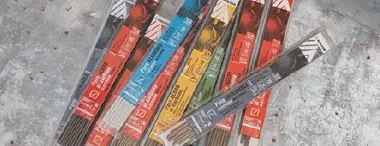TIG Welding
Process Description
The gas-shielded arc welding process with a non-consumable electrode, also known as TIG (Tungsten Inert Gas), uses an electric arc as the energy source. This arc is established between the non-consumable tungsten electrode and the workpiece, protected by an inert gas envelope.
When filler material is used, it is supplied manually in the form of a rod, similar to oxy-acetylene welding.
During the process, the TIG torch must be connected to the negative pole (−) and the ground clamp to the positive pole (+).
Applications
The TIG process is suitable for welding all types of materials, including:
- Aluminium
- Magnesium
- Oxidation-sensitive materials such as titanium
It is a predominantly manual process with a lower deposition rate than other methods, making it ideal for applications requiring aesthetically perfect finishes and high precision.
The ability to weld a specific material depends on the characteristics of the equipment. The TIG process can be performed with direct current (DC) or alternating current (AC), depending on the material to be welded.
Selection of Current Type (AC/DC)
- TIG with Direct Current (DC)
-
All SOLTER INVERTER equipment supplies direct current (DC), making them suitable for TIG welding materials such as steel or stainless steel.
- With conventional inverter equipment, arc ignition is done by contact and gas flow is manually controlled.
- There are also professional TIG machines from SOLTER that feature contactless arc ignition via high frequency (HF) and automatic gas flow control through a solenoid valve.
- TIG Alternating Current (AC)
For TIG welding with AC, specific SOLTER INVERTER equipment is required that maintains continuous high frequency (HF) operation to prevent arc extinction during the process.
These machines typically supply both types of current—AC and DC—allowing welding of materials like aluminum and titanium (with AC), as well as steel or stainless steel (with DC).
Welding Equipment
The basic TIG setup consists of:
- A power source
- A TIG torch with a non-consumable tungsten electrode
- A ground clamp
- A bottle of inert gas (usually 100% argon)
TIG Torch
The torch conducts current and shielding gas to the weld area. The tungsten electrode is rigidly held by a clamp housed within the electrode holder body.
Shielding gas flows through a ceramic nozzle attached to the torch head, directing and distributing gas over the weld pool.
Ground Clamp
Proper connection of the ground clamp is essential. The cable’s position and secure fastening are critical: a loose cable can cause poor contact, overheating, arc interruption, or weld defects.
The contact area must be clean and free of paint, varnish, oils, or other substances that could hinder electrical conductivity.
Welding Parameters
Electrode
Commonly used electrodes are tungsten with thorium. As a guideline, recommended welding currents are:
| Electrode Diameter | Welding Current |
|---|---|
| 1,6 mm | 3-35 A |
| 2,0 mm | 30-100 A |
| 2,4 mm | 100-160 A |
Electrode Preparation
Proper preparation of the electrode tip is crucial as the grinding angle directly affects arc shape:
| Grinding Angle | Welding Current |
|---|---|
| 30º | 3-35 A |
| 60-90º | 30-120 A |
| 90-120º | 120-160 A |
Technologies
- Scratch Start:
- The arc is initiated by touching the tungsten electrode to the workpiece.
- Lift-Arc Start:
- The arc is struck by touching and then lifting the tungsten electrode from the workpiece, avoiding electrode contamination.
- High Frequency (HF) Start:
- The arc is struck automatically without contact between electrode and workpiece, preventing electrode contamination.
- Solenoid Valve:
- Automatically opens shielding gas flow when the torch trigger is pressed and stops gas flow when released.
- Down-Slope Control:
- Allows regulation of the current decrease time at the end of welding, preventing crater formation.
- Post-Gas:
- Extends gas flow after the arc is extinguished to protect the weld pool while cooling.
Join our newsletter!
Be the first to receive our news and brochures! We promise not to overwhelm you!





